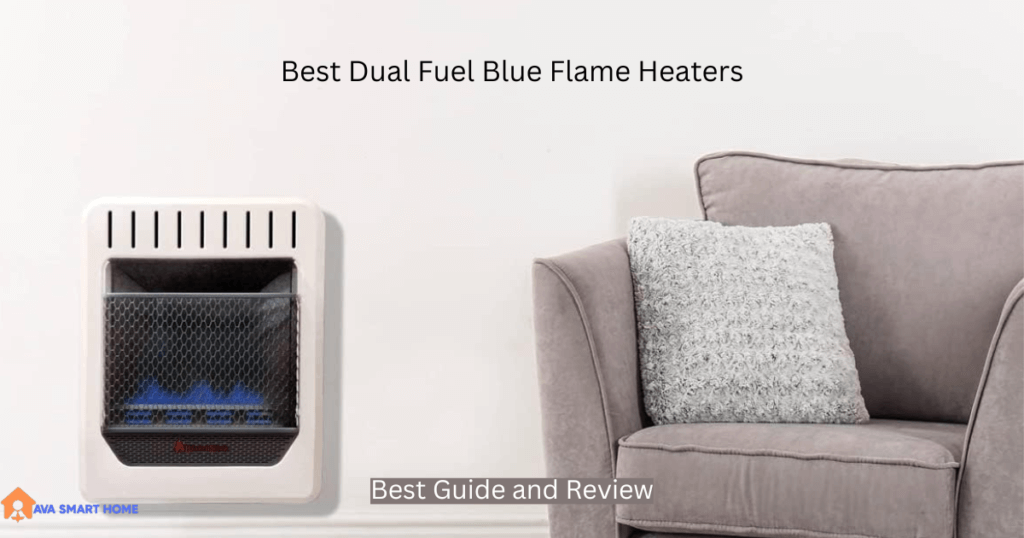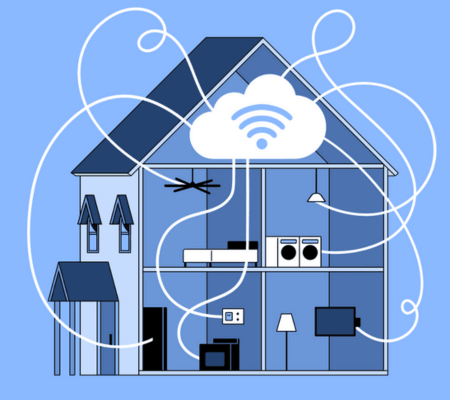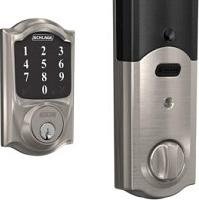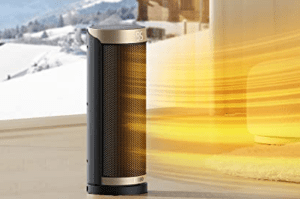Some individuals may be uncertain about the appropriate choice of heater from the options of blue flame, red flame, and infrared heaters.
The blue flame heater, also known as a convection heater, is suitable for use in well-insulated areas.

Table of Contents
ToggleWhat are the Blue Flame Heaters?
Blue flame heaters are heating devices that utilize combustion technology known as “blue flame” to produce heat. These heaters typically burn either natural gas or propane to create a flame that radiates heat. The distinctive blue flame results from complete combustion, indicating that the fuel burns efficiently and cleanly. Blue flame heaters are commonly used for space heating in residential and commercial settings.
Blue Flame Heater Pros and Cons
Pros
Cons
- Blue flame heaters use convection to heat the air
- Providing more uniform warmth throughout the room
- Blue flame heaters operate quietly
- Do not require electricity to operate
- Generally more cost-effective than electric heaters
- It produces carbon monoxide so it require proper ventilation
- blue flame heater may require professional assistance
- Limiting their portability within a home or workplace
- Lmited temperature control options compared to some electric heaters
Fuel Source
Blue flame heaters are primarily designed to run on two types of fuel:
- Natural Gas: These heaters are connected to the natural gas supply in a building, making them a convenient and cost-effective option for areas with access to natural gas pipelines.
- Propane: Propane blue flame heaters are typically used in areas where natural gas is not readily available. Propane is stored in tanks and delivered via a gas line to the heater.
Types of Fuel Used in Blue Flame Heaters
Blue flame heaters are designed for specific fuels; mixing fuels is generally not recommended. The two primary fuel types used are natural gas and propane.
Availability of Fuel for Blue Flame Heaters: The availability of fuel for blue flame heaters depends on the location and infrastructure in the area:
- Natural Gas: Natural gas is widely available in many urban and suburban areas, where homes and businesses are connected to gas pipelines. Availability may be limited or nonexistent in rural or remote locations.
- Propane: Propane is available in portable tanks that can be delivered to homes and businesses, making it accessible even in areas without natural gas pipelines. However, the availability and delivery options for propane can vary by region.
Cost of Fuel for Blue Flame Heaters
The fuel cost for blue flame heaters varies depending on location, fuel type, and market conditions. Natural gas is often more cost-effective than propane, but the exact pricing can fluctuate. Supply and demand, weather conditions, and regional factors influence propane prices. It’s advisable to check with local fuel suppliers or utility companies for current pricing and cost comparisons between natural gas and propane in your area.
Best Smart Ventless Natural Gas Blue Flame Space Heater
Bluegrass Living B30TNB-BB Ventless Natural Gas Blue Flame Space Heater
The Bluegrass Living Ventless Natural Gas Heater delivers efficient heating with style and safety. With a 30,000 BTU output, thermostat control, and the ability to warm up to 1400 sq. ft., it’s perfect for various spaces.

Let’s explore why this heater is a reliable choice for your home.
- Efficient Heating: This heater uses natural gas for powerful and effective heating in your home.
- Thermostat Control: Customize your comfort with High, Medium, and Low settings.
- Stylish Design: Its sleek and modern profile fits seamlessly into any room. Choose to mount it on the wall or place it on the floor.
- Safety First: Equipped with a pilot oxygen depletion sensor, it shuts down if it detects low oxygen or carbon monoxide, ensuring safety.
- Convenient: Works without electricity, making it reliable during power outages. Includes a blower and Base Feet for added convenience.
The Bluegrass Living Ventless Gas Heater combines efficiency, style, and safety to keep your home warm and comfortable. Enjoy warmth and peace of mind all winter long.
Heat Output
The heat output of a blue flame heater refers to the amount of heat energy the heater generates and emits into the surrounding space. It is typically measured in BTUs (British Thermal Units) per hour and can vary depending on the heater’s size and design.
Benefits to Heat Output from a Blue Flame Heater:
- Even Heating: Blue flame heaters provide consistent and even heat distribution throughout the room, helping to maintain a comfortable temperature.
- Efficiency: These heaters are designed for high heat efficiency, ensuring that a significant portion of the fuel’s energy is converted into heat.
- Quick Warm-Up: Blue flame heaters can quickly heat a room, providing immediate warmth.
- Directional Heat: Some blue flame heaters have adjustable louvers or vents, allowing you to direct the heat where it’s needed most.
Disadvantages to the Heat Output from a Blue Flame Heater:
- Limited Range: Blue flame heaters are generally suitable for heating smaller to medium-sized spaces. They may not be sufficient for large areas or open floor plans.
- Dependency on Fuel Supply: The heat output depends on a steady supply of natural gas or propane, so interruptions in the fuel source can affect heating performance.
- Localized Heating: While they provide even heating, blue flame heaters primarily heat the immediate area where they are installed. They may not be effective at heating multiple rooms unless the doors are left open to allow heat circulation.
Safety Considerations
Oxygen Depletion Sensor (ODS) in Blue Flame Heater Models
Many modern blue flame heaters have an Oxygen Depletion Sensor (ODS). This safety feature monitors the oxygen level in the room where the heater operates. If the oxygen level drops to an unsafe level, the ODS will automatically shut off the heater to prevent the risk of carbon monoxide (CO) buildup and oxygen depletion. This is a critical safety feature, especially in enclosed spaces.
Other Safety Concerns when Using a Blue Flame Heater Model:
- Ventilation: Adequate ventilation is essential when using a blue flame heater, as it ensures proper combustion and prevents the accumulation of harmful gases like carbon monoxide. Always follow the manufacturer’s guidelines for room size and ventilation requirements.
- Clearance: Maintain proper clearance around the heater to prevent combustible materials from coming into contact with the hot surface. Follow the manufacturer’s recommendations for clearance distances.
- Flammable Materials: Keep flammable materials such as curtains, paper, and furniture away from the heater to reduce the risk of fires.
- Regular Maintenance: Perform routine maintenance on your blue flame heater, including cleaning the burner and checking for leaks in the gas supply line. Having a professional inspect and service the heater annually is a good practice.
- CO Detectors: Install carbon monoxide detectors in your home, especially in areas where you use gas heaters. These detectors can alert you to CO, a colorless, odorless gas that can be produced by incomplete combustion.
- Supervision: Never leave a blue flame heater unattended while in operation, especially if there are children or pets in the vicinity.
- Follow Instructions: Always follow the manufacturer’s instructions for installation, operation, and maintenance to ensure your blue flame heater’s safe and efficient use.
By adhering to safety guidelines and using a blue flame heater responsibly, you can enjoy its benefits while minimizing potential risks.
Installation Considerations
When installing a blue flame heater, several important considerations should be taken into account:
- Location: Choose an appropriate location for the heater that provides even heat distribution and follows the manufacturer’s recommendations for clearance from combustible materials.
- Ventilation: Ensure adequate ventilation in the room to prevent the buildup of harmful gases and to support proper combustion. Proper ventilation is crucial for safety.
- Gas Supply: Ensure that the gas supply line (natural gas or propane) is correctly connected and leak-free. Professional installation may be necessary to ensure safe and proper gas line connections.
- Mounting and Anchoring: If your blue flame heater is wall-mounted or freestanding, follow the manufacturer’s instructions for secure mounting or anchoring to prevent accidental tipping or damage.
- Electrical Connection: Some blue flame heaters may require electrical power outage for ignition or blower fans. Ensure that the electrical connections are made under the manufacturer’s instructions.
- Regulations: Comply with local building codes, regulations, and safety standards for installing gas appliances.
- Professional Installation: In many cases, it is advisable to have a qualified technician install the blue flame heater to ensure proper setup and safety compliance.
Vent-Free Options with Blue Flame Heaters
Heater Corporation: Vent-free blue flame heaters, or ventless or vent-free gas heaters, do not require a chimney or flue to exhaust combustion byproducts outside. Instead, they are designed to burn fuel efficiently and release heat directly into the room. Here are some considerations related to vent-free options
Advantages:
- No need for a chimney or flue, reducing installation complexity and costs.
- High energy efficiency as heat is not lost through a vent.
- Quick and convenient heating solution.
- Suitable for spaces where traditional vented heating systems are impractical.
- No electricity is required to keep you warm during power outages.
Disadvantages:
- Strict ventilation requirements are crucial for safety, as vent-free heaters release combustion byproducts, including water vapor and small amounts of carbon monoxide (CO), into the room. Adequate fresh air is necessary to prevent CO buildup.
- Some people may be sensitive to the combustion byproducts, leading to discomfort or health concerns.
- Vent-free heaters are not recommended for continuous, long-term use in bedrooms or other enclosed spaces where occupants spend extended periods.
- Regulations and restrictions on vent-free heaters vary by location, so it’s important to check local building codes and regulations before installation.
Altitude Restrictions on the Use of a Blue Flame Heater
The operation of blue flame heaters can be affected by altitude due to changes in air pressure. At higher altitudes, there is a reduction in atmospheric pressure, which can impact combustion and heat output. Manufacturers often specify altitude restrictions in their product documentation. These restrictions typically indicate the maximum altitude at which the heater can operate safely and efficiently.
Infrared Heaters
Infrared heaters may pose a safety risk as they can cause fires when placed near combustible materials.
Blue flame heaters have a slower heating speed than infrared heaters, making infrared heaters a wise choice for quickly heating a room.
An infrared heater quickly heats a room by directly warming the objects inside.
Blue flame and infrared heaters can be installed in any home room for supplemental heating.
Proper ventilation is necessary when using a blue flame or an infrared heater.
Conclusion
The ProCom Heating ML3PTG Heater combines power, style, and safety to keep your spaces cozy and secure. Say goodbye to the cold and welcome comfort with this versatile heater.
If you live at a high altitude, choosing a blue flame heater that is rated for your specific altitude range is crucial. A heater not designed for higher altitudes can reduce heating performance, inefficient combustion, and potential safety risks. Always follow the manufacturer’s guidelines regarding altitude restrictions and consult a professional installer if you have concerns about using a blue flame heater at high altitudes.










